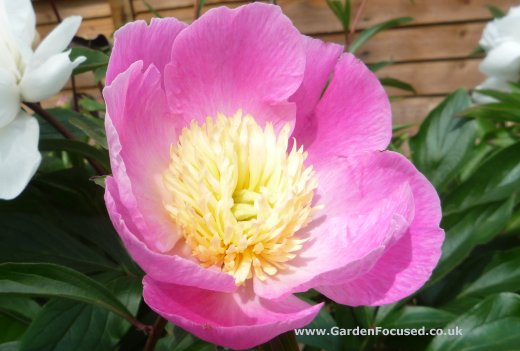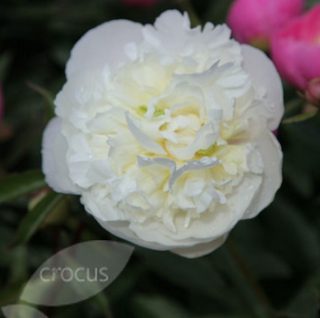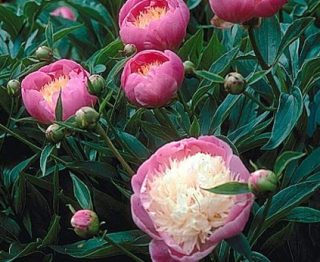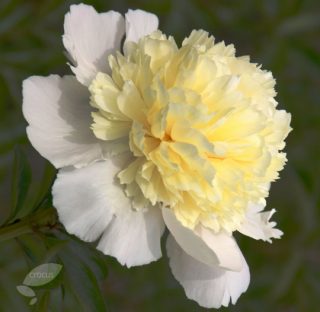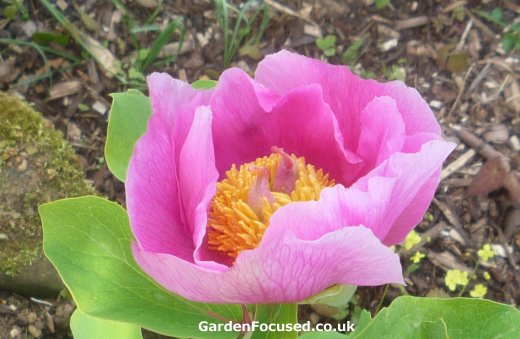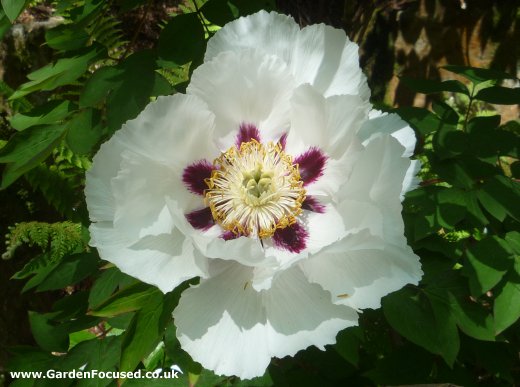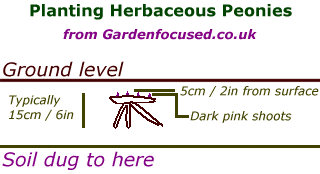GROWING HERBACEOUS PEONIES
Article by DavidMarks
There are thousands of varieties of peonies however they come inthree different forms. Herbaceous peonies, the subject of this article, whichgenerally grow up to about 1m / 3ft tall and wide. The second is the tree peonywhich tends to be taller and definitely wider. There is a less well-known, third type called"intersectional" or "itoh” peonies which are a half way housebetween the two types. The majority of peonies cultivated by amateur gardenersare the herbaceous “paeonia lactiflora”.
Use the checklist below to decide if herbaceous Peonies are suited to your needs and garden conditions
- They do best in full sun but will grow well in semi-shade.
- They are fully hardy in all areas of the UK.
- They grow well in most soils although
overly
acid ground may cause them problems. They prefer heavy clay type soils but will rot if the ground is water-logged.
- They withstand drought well, rarely requiring any hand watering.
- Peonies are low maintenance plants. They benefit from a ten minute clear up in autumn and will give of their best if fertiliser is applied twice a year.
- The majority benefit greatly from a plant support frame to stop the flowers flopping over.
- Many varieties flower for about four weeks (see our section on
varieties below), producing large attractive flowers in late spring to early summer.
- They are pest free, slugs and snails will only eat them as a last resort. If over-watered they can suffer from fungal diseases but little else troubles them.
- The foliage dies down in winter. They grow to a height and spread of just under 1m / 3ft depending on the variety.
Paeonia Immaculee
WHEN DO PEONIES PRODUCE FLOWERS?
There is no formal classification which defines when herbaceous peonies begin to produce flowers but the terms shown below are in general use. The specific dates are the average for the UK, in cooler areas it will be a week or two later and in warmer areas a week or two earlier. The length of time over which flowers are produced is dependent on the variety.
- Very Early – flowering begins early May
- Early – flowering begins mid to late May
- Mid – flowering begins early June
- Late – flowering begins mid June onwards
Paeonia Bowl of Love
BEST CONDITIONS TO GROW PEONIES
Peonies do best in full sun but they can grow well if the position is part-shaded. They will grow well in both normal and clay soils, they are probably best avoided if your ground is lighter / sandier than normal.
They dislike water-logged conditions because it rots the roots and the crownof the plant. In heavy clay they will appreciate a layer of horticultural gritbelow the roots at planting time to help with drainage.
The flowers of peonies are large by any standards and the stems sometimesn have difficulty in supporting them. For this reason they are best grown in a position which is not subject to strong winds. They respond well to being staked but even so, strong winds can damage them.
DIFFERENT VARIETIES OF PEONIES
Choosing a variety of peony can make a huge difference to the length of flowering and your enjoyment of this plant. In the past many website articles and books failed to take into account many varieties. As a general rule, though not always, the lactiflora hybrids perform very well in the UK climate.
All herbaceous peonies are fully hardy throughout the UK so the choice ofvariety comes down to the flowers and how long they last. We list below some ofthose we recommend, however, it all comes down to personal preferences in theend.
If you plan to buy your peony online then it is important to buy good quality ones. There are many suppliers of lower quality peonies at cheap prices but the plants inevitably take a couple of years longer to establish and never produce the same number of quality flowers. With peonies, quality at the outset, really does count.
CORAL SUNSET
As far as peonies are concerned, Coral Sunset is a recent introduction dating back to only 1981. It stands out head and shoulders from much of the competition on two counts. First the flowers are a stunning shade of coral, changing slightly as they age. Second, it rarely needs staking making it an ideal, low maintenance garden plant. It has the following characteristics:
- Full name is Paeonia 'Coral Sunset'
- Height and spread 85cm / 34in
- Coral coloured medium to large flowers produced early to mid-seasonwhich fade to ivory white
- The flowers are scented but not strongly
- An excellent variety for normal garden use
- The flowering period is three weeks
- Has an American Peony Society Gold Medal.
Peony Coral Sunset
DUCHESSE DE NEMOURS
This variety dates back over 150 years and is still one of the most popular of all the peonies for cut flowers. It has the following characteristics:
- Full name is Paeonia lactiflora 'Duchesse de Nemours'
- Height and spread 85cm / 34in
- White medium to large double flowers produced mid-season
- The flowers have a relatively strong and sweet scent
- The most popular peony for cut flowers
- The flowering period is four weeks or more
- Has the RHS Award of Garden Merit.
Peony Duchesse de Nemours
Click here to buy a top quality Peony Duchesse de Nemours online with a reliable five year guarantee from Crocus, your GardenFocused recommended supplier.
BOWL OF BEAUTY
This variety dates back to 1949 and was bred in Holland. it produces stunning fuchsia-pink flowers with a white centre giving the impression of a full double. It has the following characteristics:
- Full name is Paeonia lactiflora 'Bowl of Beauty'
- Height and spread 80cm / 32in
- Large flowers up to 25cm / 10in wide with fuchsia-pink outer petalsand white inner ones. One of the most stunning peony flowers
- The flowers have a relatively strong and pleasant scent and areproduced mid-season
- Very popular for cut flowers.
- The flowering period is four weeks or more
- Has the RHS Award of Garden Merit.
Peony Bowl of Beauty
Click here to buy a top quality Peony Bowl of Beauty online with a reliable five year guarantee fromCrocus, your GardenFocused recommended supplier.
LAURA DESSERT
Dating back to 1913 this our favourite peony for the garden. The stems are strong and the flowers are well supported in normal growing conditions. It will only require staking in windy conditions. The lemon and white flowers are not the biggest but for sheer style and beauty they are the best. It has the following characteristics:
- Full name is Paeonia lactiflora 'Laura Dessert'
- Height and spread 80cm / 32in
- Medium sized flowers up to 20cm / 8in wide with white (tinged pink) outer petalsand clear yellow inner ones turning white as they age
- The flowers have a relatively strong and pleasant scent and areproduced mid-season
- Strong grower suitable for growing without support in most gardens
- The flowering period is four weeks
- Has the RHS Award of Garden Merit. Very similar appearance toPrimevere and Golden Dawn.
Peony Laura Dessert
WHITE WINGS
We include this variety because it does better than most other peonies in a shaded position. The flowers are single, pure white with a centre that turns golden yellow as it opens. Another very similar variety is Wrinkled White but that needs full sun. It has the following characteristics:
- Full name is Paeonia lactiflora 'White Wings'
- Height and spread 85cm / 34in
- Large, single flowers up to 20cm / 8in wide with white outer petalswith a golden yellow centre
- The flowers have a slight scent and areproduced mid-season
- Strong grower suitable for growing without support in most gardens
- The flowering period is three weeks
- It will grow well in semi-shade unlike almost all other peonies
- Has an American Peony Society Gold Medal.
Click here to buy a top quality White Wings online from Kelways, your GardenFocused recommended supplier for this variety.
PAEONIA CAMBESSEDESII
This is one of our favourite peonies but it does need some warmth to produce the best flowers. We have seen them growing successfully in RHS Wisley. It has the following characteristics:
- Full name is Paeonia Cambessedesii
- Height and spread up to 60cm / 2ft
- Medium sized, single flowers up to 10cm / 4in wide with pink petalsand a golden yellow centre
- The flowers have a slight scent and are produced from late Marchonwards
- Strong and compact grower suitable for growing without support in most gardens
- The flowering period is three weeks
- It needs full sun and to be grown in warmer parts of the UK
- Has an RHS Award of Garden Merit
Paeonia Cambessedesii
Click hereto buy a top quality Paeonia Cambessedesii online fromAshwood Nurseries, your GardenFocused recommended supplier for this variety.
PAEONIA ROCKII
Not one of the commonest of peonies but certainly the flowers must rate as one of the most beautiful.
This is a tree peony which grows to 2m / 6ft high and 1m / 3ft wide.It does tend to maintain a rather lax and unruly shape but the beauty of theflowers make up for this.
It flowers in late spring and is fully hardy. One to consider if you want a peony that none of your neighbours will have!
Peony rockii
WHERE AND WHEN TO BUY PEONIES
Peonies are sold in two forms, containerised plants and field grown roots.As far as price goes, field grown roots are the cheaper, and best, option.
FIELD GROWN PEONY ROOTS
This is the traditional way to buy peonies. The roots are harvested (often by machine) in autumn before any harsh frostsoccur. They are then cleaned of excess earth and trimmed up ready forpacking and sale. See below a video showing how one of the major producers harvest peony roots.
Sounds simple and straightforward doesn't it! Well, it'snot and there is a world of difference between a well cultivated andharvested peony root compared to one grown to just average or low standards.
We summarise below how the best peony roots are grown, you will then seethat shortcuts can be made to save money. Those shortcuts result in poorquality roots which will take longer to establish, produce inferior flowersand can be prone to disease. The more shortcuts taken, the lower will be thequality of the roots
YEAR 1
Carefully grown two year old peony roots are planted in autumn in open ground. They are cultivated in the normal way for two years.
YEAR 3
In autumn the peony roots are dug up and divided into two. One of the divisions is replanted in open ground with the intention of letting it grow for two years to continue the growth cycle. The other division is also replanted but in a separate field and left to grow for one year in readiness for sale.
YEAR 4
The roots intended for sale are dug up and prepared for sale as described above. Note that commercially grown peony roots are grown in soil which is typically much more sandy than you would expect. This makes the harvest process easier, the roots cleaner and less prone to fungal diseases.
Field grown peony roots are normally offered for sale in October and November and are normally cheaper compared to containerised peony plants.
CONTAINERISED PEONY ROOTS
Ideally these are grown in a similar way as described above but when the roots are harvested for sale they are put in pots with compost to hold them in place. The advantage of this is that the plants can be sold at any time. In general the plants are as good quality as field grown roots (if looked after corrected when in their containers) however they are almost always more expensive.
WHERE TO BUY PEONY ROOTS
If you have read the above section you will understand that not every peony root is equal to others. Almost by definition cheaper peony roots, especially those at very cheap prices, will be of significantly lower quality compared to well grown ones.
Your only guarantee of quality is to buy from a reputable source. Thesuppliers we recommend in the varieties section aboveare known to supply peony roots in good condition.
HOW AND WHEN TO PLANT A PEONY
Peonies can live up to 80 years so it's important to plant them correctly. Follow the steps below:
- Choose a sunny spot which is not in the shade for 6 hours each day fromApril to September. If you can only provide a peony with a less sunny positionchoose the variety White Wings (see ourdescription above).
- Choose a position which does not get water-logged. Improve drainage if necessary by adding a couple of spade fulls of well-rotted compost and horticultural grit to the soil when you plant the peony.
- Dig a hole about 30cm / 12in deep and wide. Break up the soil incorporating any compost. Add three handfuls of fish, blood and bone fertiliser (or bonemeal) to the dug soil and work it in.
- Replace sufficient soil back in the hole so that when you lay the peony root in the hole the topmost bud will be only 5cm / 2in below the soil surface. See the diagram below.
- Place the roots in the hole and infill with the dug soil / compost / fertiliser. Firm the soil down around the roots reasonably firmly as you infill.
- Finally, water well if the ground is at all dry.
CARING FOR PEONIES
Peonies require very little care once established and are one of the mostmaintenance free long tem plants. In late autumn when the foliage and stemsare dying down (but not before) remove all fallen leaves and dying stems -burn them is the best solution. If there are trees or other shrubs nearbywhich shed leaves in large numbers, remove them from the surface on andaround the peony.
In early spring scatter a couple of good handfuls of fish, blood and bonearound the plants and very gently work it into the soil surface. In mostsituations peonies do not require much feeding but on lighter soils it isworthwhile.
If your soil is light and sandy it will be worth applying an annual
mulch around the plants. Be careful though to keep the mulch away from the crown of the plant. Apply the mulch in a band of about 45cm / 28in wide about 60cm / 2ft away from the centre of the plant. If you apply mulch over the crown area it can cause it to rot.
HOW TO SUPPORT PEONIES
Most peonies produce larger than average flowers and in many cases the stems are not strong enough to support them in windy or heavy rain conditions. It only takes one day of high rainfall or a strong winds to destroy the look of the plants. The solution is to provide a framework which supports them.
If the frame is put in place when the plants are 10cm / 4in or so tall theywill naturally grow through the framework (if the spacing size is correct) andquickly it will be completely hidden. That's a big "IF" though because it is soeasy to forget to put the frame in place at the correct time.
If the frame is put in place too late (and peonies grow very quickly fromearly spring onwards) it is a nightmare to try and thread the stem throughthe support without damaging them and the buds. There are several solutionsto this problem and we outline a few below.
PERMANENT PEONY SUPPORTS
These are the best lookingand by far the most convenient method of supporting your plants. Goodquality ones will last 15 years or more and also look great when the plantshave died down. You put them in place for the first time and leave themthere for life. They are expensive, without a doubt, but they do the jobperfectly, look great in winter and there will never be a need to rememberto put supports in place again.
The ones suitable specifically for peonies are trumpet supports, grow-through-rings and link stakes.
CHEAP PEONY SUPPORTS
Typically these come in a greenplastic finish with thinner metal inners, they rarely come with a guarantee.These need to be taken in over winter if you want them to last up to threeyears. If left out over winter, not only will they quickly become unusablebut also they are not particularly attractive.
Most will almost certainly last a year but after that it's variable. Onesuch support is sold by
Megatrade.It certainly is cheap but you definitely only get what you pay for.
HOME MADE SUPPORTS
For those on a real budget, youcan make your own peony plant supports. They rarely look attractive butwhile the plant is in full leaf they will be hidden if you have made them tothe correct size. We've never done but
click here for thelink to a page where Monty Don shows you how to make your own plant support.
HOW AND WHEN TO PRUNE PEONIES
Herbaceous peonies grow to roughly 1m / 3foot high and wide so allow enoughspace when you plant them. Pruning them to shape or to restrict their sizeis not recommended.
In autumn, when the foliage and stems start to die down, remove them to avoidfungal infections to the crown of the plant.
Peonies make excellent cut flowers. It's best to cut them before they are fully open, they will open up fully in the vase. Immediately after you cut them put them in water.
PESTS AN DISEASES OF PEONIES
Peonies are almost never affected by pests, slugs, snails and birds seem to avoid them. They can be home to ants which are attracted to a sweet goo they exude but the ants rarely do any significant damage. The main disease to affect peonies is wilt which is described below.
PEONY WILT
This is a fungal infection which first shows signs in late spring to early summer. At first the leaves will have random brown patches on them. Later on the leaves on entire stems wilt, curl and become brown. Flowers may also become affected and looking malformed. Usually is does not affect the whole plant, a single or a few stems are commonly affected.
In the UK there is no chemical cure. The best course of action is to pruneout infected stems being careful to sterile the secateurs (with a wipe ofmethylated spirits or similar disinfectant) in between each cut. This will avoidspreading the fungus.
Clear up any dead leaves or other decaying matter around the plant. Burn everything, do not put infected leaves or stem on the compost heap.
The condition thrives in damp areas and those with poor air circulation. To help with this prune away any weak growing stems from the centre of the plant to allow good air circulation. If this is done the plant may well recover. In the long term, good hygiene by removing all dead and decaying matter at the base of the plant should prevent any further recurrence.
GROWING PEONIES IN CONTAINERS
Some articles suggest that smaller varieties of peony can be grown in containers but we don't recommend this. There are plenty of other shrubs and perennials which adapt to container growing far better.
PEONY SUMMARY
Below we list the key strengths and weaknesses of Peonies.
| HARDY |
|
| CLAY SOIL | Yes but not water-logged |
| SANDY SOIL | Yes if improved |
| DRY SOIL | No |
| SHADE | No, partial, full sun (but see 'White Wings') |
| EVERGREEN | No |
| EASY CARE |
|
| SMALL GARDENS | Yes |
| POT / CONTAINER | No |
| FLOWERING |
|
| FLOWER TIME | Late May to late June depending on the variety |
Other "easy-care" shrubs in this series include
Choisya, Hebes, Skimmia, Lilacs, Potentilla and
Rose of Sharon (hibiscus syriacus).

